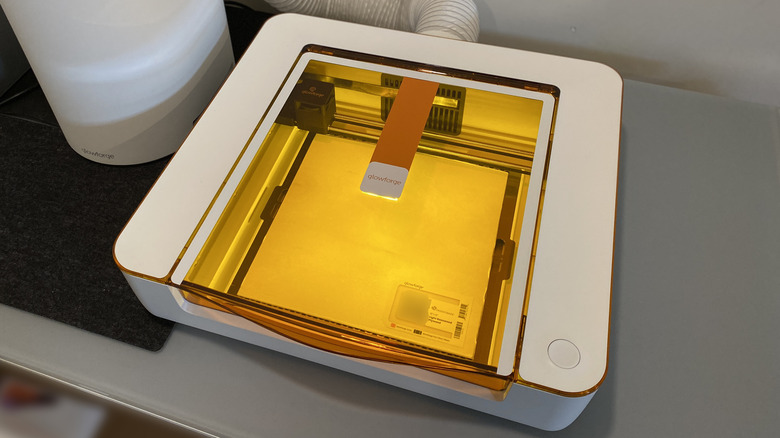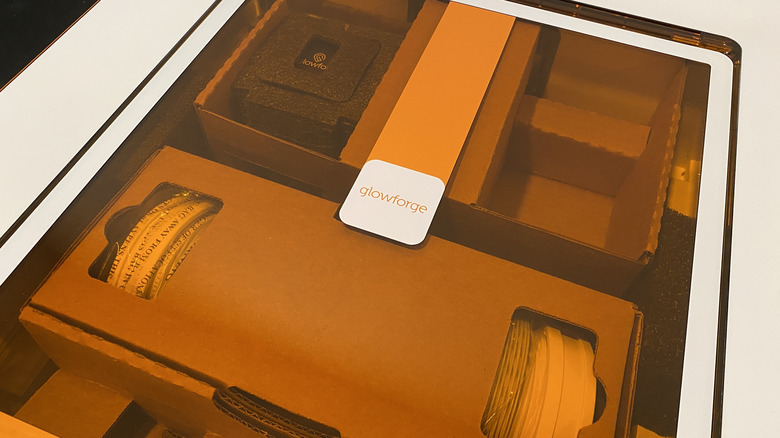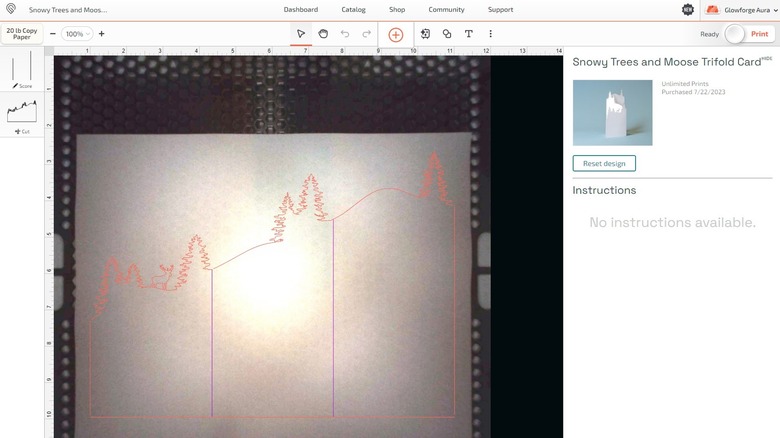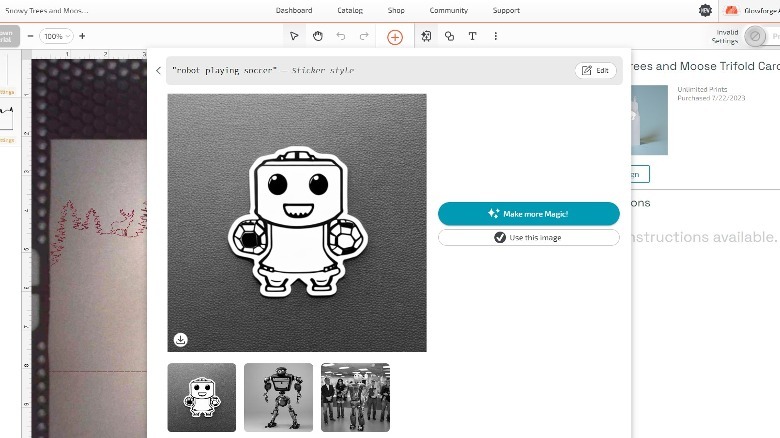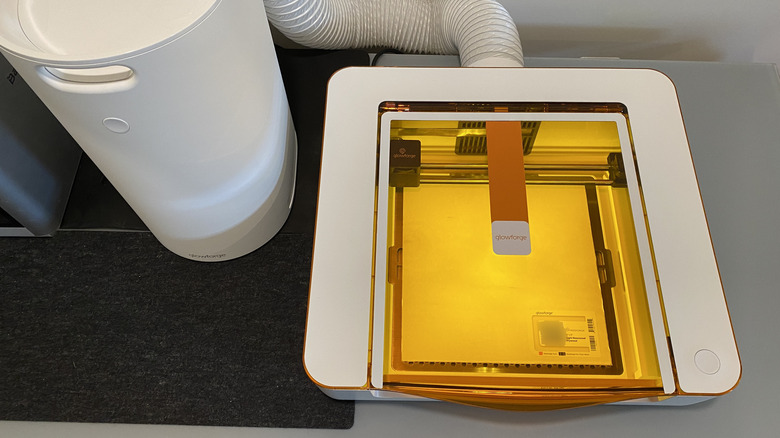Glowforge Aura Review: The At-Home Laser Cutter To Beat
- Easy to set up
- Safe to operate
- Can cut, score, or etch a wide variety of materials
- The time from thought to product is short
- Optional subscription costs add up
- Proofgrade materials are premium priced
- App is only web-based, with no standalone versions
- Wi-Fi is the only connection type
It was not that long ago that the only laser cutters that you could get for home use were either prohibitively expensive or lacking in safety features. That's changed in recent years, and one of the companies that are leading the charge to user-friendly, safe home laser units is Glowforge. Originally a Kickstarter darling back in 2015, it took three years for the dream to be realized and backers to get their first 3D laser printer. These started at around $2,500 and went higher as specifications changed.
Now they're back with the Aura, an affordable (if anything costing $1,199, can be called that) desktop laser cutter and etcher that isn't much larger than an inkjet printer. It looks like a normal printer too, which might help as the industrial look of many laser devices can be offputting. It's aimed at hobbyists or those who want to start a crafting business selling on sites like Etsy with minimal technical knowledge necessary.
Glowforge sent the Aura, Personal Filter, and a selection of Proofgrade materials for this review.
What's in the box?
The full Glowforge Aura setup was shipped in three boxes, one huge flat one with the laser unit inside, one with the large filtration system in, and a smaller but substantially heavier box with a selection of Proofgrade materials. These are pre-calibrated materials sold by Glowforge, and we'll go into that a little later on. Before that, it's time to get everything set up.
Now, this ended up being a much easier task than anticipated. Many laser etching or cutting tools released in the past decade came as flatpack kits and needed actual tools to put together. The Aura needs none of this effort and is no harder to set up than your average inkjet printer. Actually, it was easier than the last printer we used, as it puts out its own Wi-Fi hotspot to connect to for getting the device online.
The main unit is pre-assembled, as any good mass-market consumer product should be. Not that consumer-grade laser cutters are close to being that prevalent, but that's the hope of companies like Glowforge. There were no tools in the boxes, no tools were mentioned in the instructions, and the only thing needed was a sharp edge to cut the security stickers with.
Setup time
The Aura comes with foam and a couple of cardboard boxes with accessories inside the main chamber. Removing those gets you to the only tricky part of the process, which is untangling the print head from its protective foam without tugging the ribbon cable out. This can be reinserted if things don't go to plan, but it's better to take some care in the first place. The print head with the laser then magnetically attaches to the rails that move it around to cut materials.
There are a few remaining chunks of foam to remove, then the metal rails get pushed all the way to the back to align them, and then the cutting tray goes on. This raises the cutting area above the safety stainless steel sheet while getting some airflow below the materials. Then it was time to attach the vent hose to the back, remove some plastic from the sealed filter cartridge, and connect the hose to the filter unit.
The Aura has no manual power switch, and neither does the personal filter unit. Both automatically turn on when plugged into the wall and connect together via Bluetooth. It's worth mentioning that you want to keep all of the packaging down to the last smallest chunks of foam. You'll need them if you have to send the device back to the company to fix anything.
Design and Hardware
The Glowforge Aura looks very much like a laser printer, except it uses the 6W blue diode laser in a different way. That's not a terribly high-powered laser (maker CO2 lasers are often 55W or more), but it's more than enough for the types of materials that it will be used with. With that limitation, the Aura can cut materials under a quarter inch in thickness and up to a maximum working area of 12 inches by 12 inches.
The device also has two flip-down doors on the sides so that longer items like signs can be cut or engraved. This still has a 12 inches width maximum, while opening the door to different project types. The overall unit will need a deep table or countertop to work from, as it is 22 inches wide, 20.5 deep, and 5 inches high. You'll also have to take into account the orange safety lid, which adds 17 inches or so to the height when opened. This lid also has a camera mounted centrally, which is used for multiple functions we'll get to later.
The main thing here is that this laser cutter and crafting tool doesn't look like your usual industrial tool. It looks like a printer, like it belongs inside an office or crafting room and not in the cold garage or an outbuilding. That's a smart move, appealing to cottage industry makers who might not have dedicated room to practice their craft in.
What to print?
Now we're all ready to get crafty, but what to make? If you're new to this and stuck for ideas, Glowforge has a huge catalog of designs that you can pay a nominal fee for the use of, with one-use licenses or ongoing ones. These are split into categories based on difficulty, print time, commercial or personal use licenses, and things like "Art & Decor" and "Games & Activities."
This review uses mostly designs from the catalog which would normally require a Premium subscription to use. All of the designs also have suggested materials to use and how many sheets of each material you will need.
Note that you don't have to use these designs at all. You can use Inkscape or any other drawing program that can create SVG files, which you can upload to the Glowforge app and etch, cut, or engrave. This is cool, but the Aura has another neat trick. The camera in the lid of the Aura can scan your hand-drawn designs and turn them into design elements. You don't actually need to learn how to use digital drawing tools at all, as any sketched design can be turned into a printable one.
Subscription and proofgrade materials
Now, while you can create your own designs, the company makes it relatively affordable only to use its own catalog. That's through a monthly or yearly subscription, which unlocks most of the catalog for use. With single designs costing anywhere up to $60 each, paying $50 a month (or $239 if paid 12 months at a time) seems like a smaller outlay. The catalog of designs included in Premium has over a thousand entries, and other advanced tools get unlocked, like millions of vector illustrations and over 1200 fonts. Sure, these are things you could find on the internet and piece together, but anyone who has tried knows just how time-consuming that is. The subscription also unlocks Magic Canvas, a generative AI tool we'll talk about more in a minute.
While we're still talking about buying things, we'd like to talk about Proofgrade materials. These include acrylic, leather, plywood, veneer, hardwood, and draft board, and all are cut to size. Some of these are for the larger Glowforge lasers, so it's important to get under 12 inches in width and thinner than a quarter of an inch. Each material piece is covered in a protective layer, which you can write on to create your hand-drawn designs without marking the material. It also has a QR code for that material.
There is a QR code — blurred in all the photos in this review — which is read by the camera in the lid, telling the Aura what settings to use for the job. Glowforge has already pre-calibrated these for the Aura and its other laser printers, saving you time in tweaking settings. Again, you don't have to use these, but calibrating other materials will take time and wasted material as it will take multiple tries to dial things in.
App and AI creator
The web app that runs the Aura works on any device with a web browser. It represents the working area of the printer and is a hybrid view of the material to be worked with and the design to be used. Any hand-sketched images or text on the surface of the material covering is scanned and digitized near-instantly and can then be repositioned or resized as desired. It's a neat feeling seeing the material that will be cut and the digital design at the same time.
The printing process is no different from printing documents, with a button to start the process off and a button to pause the laser at any point. If tweaking settings for non-Proofgrade materials, these can be saved as presets for future use.
The advanced tools locked behind the Premium subscription give even more utility. There is a tool to make jigsaw puzzles from any image and loads of images and fonts to choose from to embellish your creations. It's a shame that these are behind the subscription, as many creators could benefit from them.
The one tool that could be worth the subscription on its own is Magic Canvas. This AI-powered tool uses generative adversarial networks to create art from text prompts. You put a short descriptive phrase into the input box, and the AI creates a bunch of options based on it. Clicking on any of the first images lets you refine the prompt, tweaking the image to your desired style or imagery. It's really quite something, especially for someone like me who has limited drawing skills.
Test cuts
Our first test of the laser was a foldable greeting card with some trees, snow, and a moose. This trifold design uses the laser to cut out the tiny details on the relief, then the full outline, and then uses a lower power mode to score the card for easy folding. This took about four to five minutes to cut out, which is pretty fast considering it has to worry about focusing on a piece of printer paper while not setting it on fire. The image above is the start of the outline cut operation after it had already scored the two lines for the folds.
Once the printer was done, all that was needed was to gently pull the cut design off the larger sheet of paper, and pop out the three little sections under the moose's body where it hadn't fully cut out. These were barely hanging on by a few paper fibers, and it's entirely possible they would have dropped out if we had been using cardstock or similar thicker material. Any print we did later on wood dropped straight out of the waste material once the job was done. It's also worth noting that as a safety feature, the laser will pause if the lid is lifted at any point or if the unit is bumped. Jobs can also be manually paused from the app if you need to leave the room and work will resume when you're back to keep a watchful eye.
Advanced projects
After playing around with a few simple designs to get the feel for the laser, we found a more complicated design from the catalog to cut out. This is a multi-part headphone stand, which we decided to make out of thin cherry plywood. As this is Proofgrade material, the QR code on the covering was read by the Aura, and it automatically fed the correct cutting instructions to the app.
Normally, to get a wood-cut dialed in, you would have to go through multiple stages of tweaking to get the depth and speed of cut you needed, without losing quality or charring the wood more than necessary. The slight hiccup was that the design was made for the larger Glowforge materials, which are 20 by 12 inches. This just meant doing the print twice, with half of the pieces removed the first time (above), and the additional parts rearranged to fit on the smaller sheet for the second time.
It's refreshing to see how user-friendly the interface is. Once the print design was ready, the servers sent it to the Aura, and the only button on the device lit up to say it was ready for printing. It took 40 minutes to cut the first half and maybe 35 to do the rest of the pieces, and we had a 3D jigsaw of spines to put together with tiny dots of glue to make our headphone stand.
Magic Canvas in action
The image above and below was made with the AI generative tool Magic Canvas. The prompt was "dinosaur skeleton doing kung-fu" — and it didn't turn out quite this well at first. The path to this point included a few rounds of letting the tool generate images that weren't really worth keeping. Perhaps the prompt had too many different ideas for the GaN network to come up with a usable design. The key was choosing the "sticker" preset, which constrains the output to simple black lines that would work as a sticker. Bingo, the second iteration was almost perfect, with a skeleton with altogether too many teeth, in something resembling a martial arts stance.
Glowforge included a bunch of laser-safe iron-on material, so we put it to the test. While the Aura did identify the green iron-on material, we double-checked that it was set only to score the lines and not fully cut. This would keep the clear backing plastic intact while cutting only the iron-on material.
The design was sent to the Glowforge and ten minutes later we had a completed design. A few minutes after that, we had a long-sleeved shirt with the design embossed on it, ready for wearing.
The competition
The pricing and target audience for the Aura is targeted at small crafters or those wanting to start an online business making things to sell. While $1,200 is a big chunk of money, as a tax-deductible expense, it begins to make more sense. The ease of use, setup, and pre-calibrated materials is also not to be understated. While hobbyists might prefer barebones machines or those that need tinkering, business owners need reliability and ease of use.
The market for other laser cutters in this price bracket is fairly sparse. There are cheaper devices like those from OMTech, which have higher-power CO2 lasers and can engrave cylindrical objects like mugs but have a more limited eight-by-twelve-inch working area.
At a slightly higher price of around $2,200, the FLUX Beamo has a similar 11.8 by 8.3-inches work area, but it does come preassembled and has many of the user-friendly features of Glowforge's machines. And xTool has a similarly priced laser engraver and cutting device, the D1 Pro, although this doesn't come enclosed. Instead, it has a small shroud over the laser head to protect bystanders from harm.
Glowforge Aura verdict
As reviewed, the Glowforge Aura costs $1,199. That's not including the Personal Filter at $399, the cost of Proofgrade materials, the costs of individual designs, or the Premium subscription, which is $50 a month or $239 yearly. That said, you don't need to use the designs in the catalog, pay for the software that runs the Aura, or use those premium materials. The Aura works just fine without the added extras and is only limited by your imagination. We've watched the laser cutter market over the years, and nothing has come close to how user-friendly, safe, and approachable the Aura is, and Glowforge should be commended for that.
It can cut, engrave, and score metal, tiles, stone, leather, wood, or almost anything that doesn't have PVC inside it (for very important safety reasons, as it creates hydrochloric acid and toxic fumes). The passthrough doors make it usable with larger workpieces, and it's insanely accurate from our testing. It does all of this at a quarter of the price of the next machine Glowforge offers, with minimal setup, minimal maintenance, and simple-to-use design tools. That can't be understated, as most other laser cutters require dialing-in when first set up, then for every new material, and have complicated processes for getting your design onto the machine. There just isn't another laser printer on the market that can match what the Aura does, except maybe the substantially more expensive Glowforge Plus.
